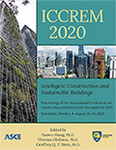International Conference on Construction and Real Estate Management 2020
Process Platforms for Onsite Assemblies: A Case Study of Work Break Down Structures in SMEs
Publication: ICCREM 2020: Intelligent Construction and Sustainable Buildings
ABSTRACT
Industrialized house-building companies predefine parameters in platforms. To identify processes platforms the use of work break down structures that support the assembly processes for small house building companies were studied. A case study of the onsite assembly activities were chosen at one small Swedish house builder that offer customization within their products. Based on the assembly processes, a work breakdown structure of the workflow predefinitions was identified for the process that didn’t compromise with product customization. Small companies can predefine elements within the product to simplify the work process on site. The work break down structure becomes a tool to find parts and process that predefine a house building platform. It can also be used for planning, delivery, cost, and resources in an overall view of the project. Because of the importance of planning during projects, together with the possible standardization of the company’s process, the use of a work break down could contribute to increase efficiency for onsite work.
Get full access to this article
View all available purchase options and get full access to this chapter.
ACKNOWLEDGEMENTS
The research study was made in the research project of Connected Worksite. We gratefully thank the interviewees at the case study company for their time and inspiration. This work was funded by the Swedish Governmental Agency for Innovation (VINNOVA).
REFERENCES
Bezelga, A. and Brandon, P.S. (1991). Management, quality and economics in building, Routledge, London, UK.
Bonev, M., Wörösch, M. and Hvam, L. (2015). “Utilizing platforms in industrialized construction.” Construction Innovation, 15(1), 84-106.
Flick, U. (2009). An introduction to qualitative research, Sage Publications Ltd.
Gibb, A.G.F. (2001). “Standardization and pre-assembly: distinguishing myth from reality using case study research.” Construction Management and Economics, 19(3), 307-315.
Gravina da Rocha, C., Kemmer, S.L. and Meneses, L. (2016). “Managing customization strategies to reduce workflow variations in house building projects.” Journal of Construction Engineering and Management, 142 (8).
Jansson, G., Johnsson, H. and Engström, D. (2014) “Platform use in systems building.” Journal of Construction Management and Economics, 32(1-2), 70-82.
Jansson, G., Viklund, E. and Lidelöw, H. (2016). “Design management using knowledge innovation and visual planning.” Automation in Construction, 72(3), 330-337.
Jansson, G., Mukkavaara, J., Elgh, F. and Lennartsson, M. (2019). “Breakdown structure in the digitalization of design work for industrialized house-building: a case study of systems building using predefinition levels of product platforms.” Proceedings of the International Conference on Construction and Real Estate Management 2019, Banff, Canada, 49-57.
Johnsson, H. (2013). “Production strategies for pre-engineering in house-building: exploring product development platforms.” Construction Management and Economics, 31(9), 941-958
Jonsson, H. and Rudberg, M. (2014) “Classification of production systems for industrialized building: a production strategy perspective.” Construction Management and Economics, 32(1-2), 1-17.
Lessing, J., Stehn, L. and Ekholm, A. (2015). “Industrialised house-building-development and conceptual orientation of the field.” Construction Innovation, 15(3), 378-399.
Miltenburg, J. (2005). Manufacturing Strategy: How to formulate and implement a winning plan, Productivity Press, New York.
Norman, E.S., Brotherton, S.A. and Fried, R.T. (2008). Work breakdown structures: the foundation for project management excellence, Jhon Wiley and Sons, Canada.
Schoenwitz, M., Naim, M. and Potter, A. (2012). “The nature of choice in mass customized house building.” Construction Management and Economics, 30(3), 203-219.
Svensson, C. and Barfod, A. (2002). “Limits and opportunities in mass customization for “build to order” SMEs.” Computers in Industry, 49(1), 77-89.
Information & Authors
Information
Published In
ICCREM 2020: Intelligent Construction and Sustainable Buildings
Pages: 190 - 197
Editors: Yaowu Wang, Ph.D., Harbin Institute of Technology, Thomas Olofsson, Ph.D., Luleå University of Technology, and Geoffrey Q. P. Shen, Ph.D., Hong Kong Polytechnic University
ISBN (Online): 978-0-7844-8323-7
Copyright
© 2020 American Society of Civil Engineers.
History
Published online: Oct 14, 2020
Published in print: Oct 14, 2020
Authors
Metrics & Citations
Metrics
Citations
Download citation
If you have the appropriate software installed, you can download article citation data to the citation manager of your choice. Simply select your manager software from the list below and click Download.
